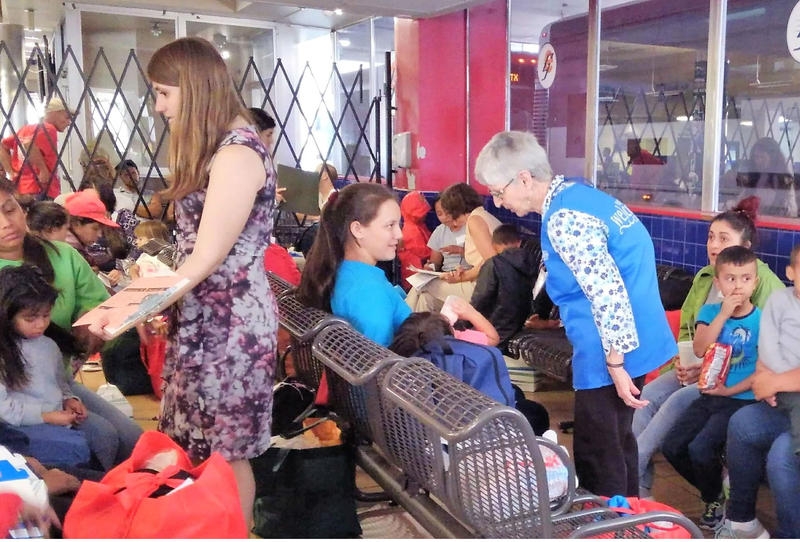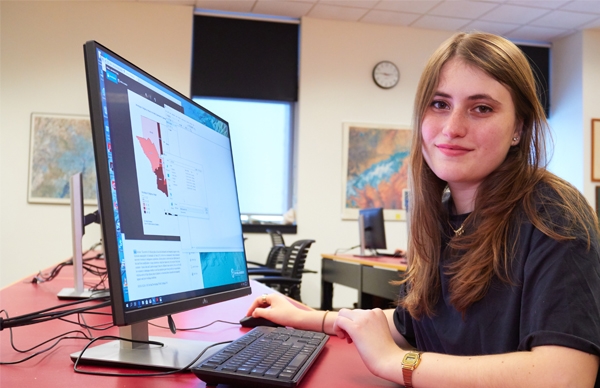Middlebury Senior Describes Front Lines of U.S. Immigration Struggle
| by Gaen Murphree

MIDDLEBURY, Vt. – The visitation room at the Karnes County Residential Center, an ICE family detention facility near San Antonio, is sterile, white, and bleak, says geography major Hannah Krutiansky ’19. There are no windows.
A guard sits in one corner constantly monitoring activity. There are tables for adults to work at. A rug demarcates the children’s play area with a chalkboard that rarely has chalk, a flat-screen TV that sometimes has kids’ cartoons and sometimes doesn’t, some blocks, a play stove, and some beat-up dolls. The facility is run for profit by the GEO Group.
“It’s a jail trying to look like a grade school,” Krutiansky said.
The Middlebury senior from New York has spent much of her past two summers at Karnes, working face to face with asylum seekers, listening to their stories, as an intern with the San Antonio–based RAICES (Refugee and Immigrant Center for Education and Legal Services).
For Krutiansky, who plans to become an immigration attorney, the work is deeply personal. On her mother’s side, both grandparents are Holocaust survivors. On her father’s side, the family fled pogroms in the Ukraine to emigrate to Argentina. Her very name ties her to these weighty events: she’s named for both Hungarian resistance fighter Hannah Senesh, whom the Nazis executed by firing squad at age 23, and for her grandfather’s sister, who died in Auschwitz.
“I don’t remember learning about the Holocaust,” said Krutiansky. “It was just … this is where my family comes from. This is our story.
“My grandparents were denied their right of existence because of their religion,” she continued. “I think every human being has the right to survive. I’ll never forget a father I spoke to preparing him for his asylum interview. He said, ‘All I want to do is go to bed at night and not have to be afraid for my life.’ I think that’s baseline.”

Hannah Krutiansky ’19, a geography major from New York, has worked for two summers with a group offering legal aid to asylum seekers in Texas.
Before detainees reach a facility like Karnes, said Krutiansky, many of them are held in predetention facilities dubbed by the detainees as “la hielera” (the ice box), because of the freezing temperatures, and “la perrera” (the dog pound), for its chain-link fences.
“The team at Karnes is responsible for completing legal intakes, credible-fear preps, and Know-Your-Rights talks,” said RAICES Director of Education and Outreach Barbara Peña. The credible-fear interview is a critical first step toward release from the facility and an asylum hearing—vs. deportation.
Krutiansky, who speaks fluent Spanish, worked mostly with asylum seekers from El Salvador, Honduras, and Guatemala. A recent report from Doctors Without Borders characterized the region as “one of the most violent regions in the world today” and described a “humanitarian crisis” of widespread murder, rape, extortion, “horrific violence,” and kidnapping combined with political instability. People migrating to the United States, according to the report, are “running for their lives.” The UNHCR (the office of the United Nations High Commissioner for Refugees) has called for greater international cooperation to protect these refugees.
When an asylum seeker finally sits down to prepare for the credible-fear interview, it’s often “the first time they can process what they have just survived,” Krutiansky said.
“Some women will break down; we always have tissue boxes. Then there are women who will just be blank. I’ll never forget a woman who, the gangs were targeting her and they showed up at her house one day and they said, ‘Five minutes of pleasure or your son.’ They took her and gang raped her, and they videotaped it… . All she could remember was ‘Five minutes of pleasure or your son,’ and her face was deadpanned. I guess that’s how she was protecting herself. That was her survival strategy.”
The work “can take an emotional toll,” noted Peña. “Day in and day out, Hannah’s commitment was unwavering. The hours are long. Ten, 12 hours, sometimes longer. Hannah worked incredibly hard on behalf of every family she encountered.”
When Krutiansky returned to Karnes in early August this past summer, in the aftermath of the Trump administration’s policy of family separation and “zero tolerance,” she found a system in chaos and an atmosphere of despair.
“Any day you didn’t know what you were walking into,” said Krutiansky. “But the worst part was the hopelessness. The previous summer these people had suffered so much but there was hope: hope they were going to be released, hope they could keep moving forward. This summer, there was no hope… . I literally heard a father say, ‘I may die when I go back. It’s okay. I just need to leave this terrorization.’”
Just before Krutiansky returned to Karnes, a detainee hunger strike received national attention. A little over a week after her arrival, an ICE raid again put Karnes in the national spotlight.
“It was Wednesday, August 15,” said Krutiansky. “I’ll never forget.”
She and the RAICES staff were working with clients, when suddenly a prison officer told them to evacuate the facility. Attorneys challenged the orders, but prison officials insisted they go immediately.
“We stepped out of visitation and the hallway was filled with ICE officers dressed as soldiers. Bulletproof vests, guns, handcuffs, shields… . Everyone’s so shaken. No one knows what’s going on. We have to step outside. We see the whole area is now guarded up. No one can leave or enter the facility.”
Later, they learned that ICE—fearing another hunger strike—had rounded up fathers they believed to be “troublemakers.” The men were handcuffed, driven off the premises, and held overnight before being returned to Karnes, said Krutiansky.
On Friday morning, RAICES was allowed to return.
“A father walked in with his seven-year-old son. They had been separated twice now, and the son is just clinging to his father’s leg. The father wanted to talk to the attorney alone. So, he plopped the son on the rug and—I’ve never seen anything like this—the child just folds into himself and starts sobbing.”
Krutiansky sat down next to him.
“A tactic I’d found working with separated kids in New York is counting. So I was like, ‘OK, let’s count together. Uno, dos.’ ‘How old are you?’ ‘Let’s get to your age. ¿Cuántos años tienes?’ Slowly he’s coming out of his hands and looking at me like, ‘Can I trust this person?’”
Krutiansky could see “on his ID” that he’d turned seven in June so she asked, “‘Were you here in the U.S. when you turned seven?’ And he said, ‘Yes. Right after I’d been separated from my dad and crying every morning, Where is my dad? Where is my dad?’ So this boy was literally six, taken from his dad on his seventh birthday, and was marked by that. He’s just trying to play. He takes these dolls and he presses his body on top of the dolls and he says, ‘This is what they’re doing to me and my dad.’ Then he describes watching his dad get shackled in front of him, this seven-year-old boy.”
Connections between Krutiansky’s work with asylum seekers and her studies at Middlebury thread back and forth. Funding from Middlebury’s Center for Careers and Internships helped her embrace these life-changing experiences. Her geography capstone project focuses on U.S.-Central American migration. And in February, she’ll be leading other students on a Center for Community Engagement alternative break trip to San Antonio, to work with RAICES and with Karnes asylum seekers.
Above all else, Krutiansky said she’s been inspired by the migrants themselves.
“If I have an ounce of their bravery and resilience and strength—if only I have an ounce of that—I will be set for life.”
For More Information
Center for Careers and Internships
Center for Community Engagement

